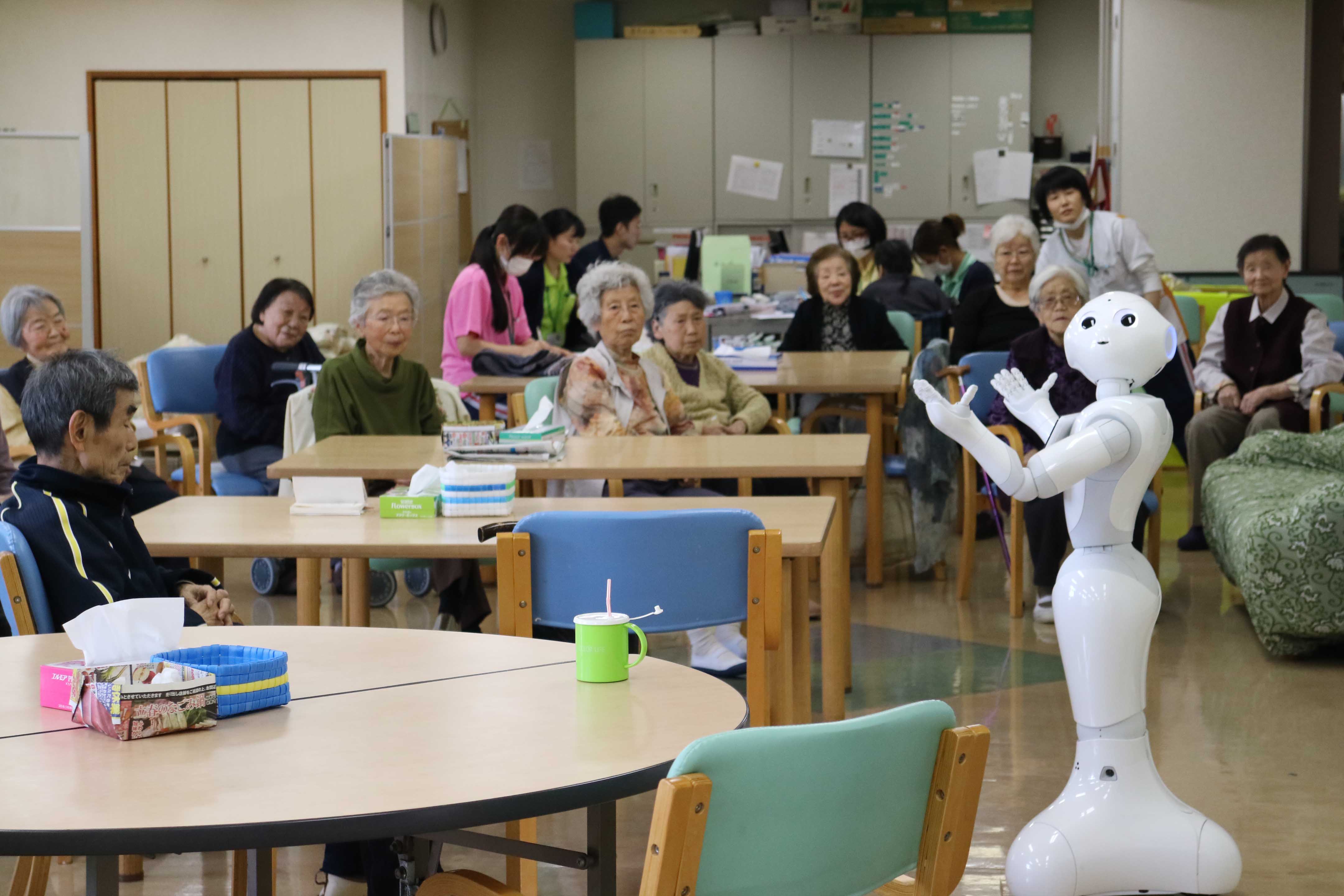James Wright
Success and Failure of Public Innovation Policies in Japan
A Case Study of Care Robots
2019/01/17
Overview
In contemporary developed societies increasingly dominated by science and technology, one of the most pressing questions facing governments is why public innovation policies succeed or fail. What factors between the creation of policy and its implementation, between the techno-imaginary and the reality of technology use, intervene to reconfigure and repurpose state ambitions of national innovation?
This research study focuses on a large and growing area of public innovation policy in Japan that is increasingly having a global impact: the development and use of robotics in elderly care. While care robots seem to hold out the promise of supplementing or even substituting for human care labour, despite significant state investment their actual implementation has so far fallen short of making a substantial difference to the acute and growing care labour shortage in Japan. In analysing this specific case, the present study aims to address broader questions beyond Japan and beyond robotics, about the factors underlying the success or failure of public innovation policies more generally.

Background
Elements of the Japanese government have long utilised national innovation policy to pursue robots as a technological solution to perceived problems attributed to the aging population. Across different ministries, the government has spent over 15 years planning and funding large-scale public technology research projects in the service robotics industry to the tune of tens of billions of yen, or hundreds of millions of euros (Wagner 2010, Wright 2018). This substantial investment represents a significant state commitment to the ongoing transformation of care in Japan in an increasingly technocratic configuration combining elements of welfare systems in Europe and North America with the efficiency and innovation of high-tech robotics used in Japanese factories and research institutes.
In May 2015, Prime Minister Shinzō Abe announced the establishment of the Robot Revolution Initiative, promising to “spread the use of robotics from large-scale factories to every corner of our economy and society.” In the same year, the Headquarters for Japan’s Revitalization, headed by Abe, released a comprehensive robotics strategy for Japan, which aimed to increase the market for nursing care robots to ¥50bn (approx. €400m) by 2020, while completely eliminating widespread back pain caused by care work. The 5th Science and Technology Basic Plan (2017-2020) continues this trend, mentioning robots, ICT and AI as key areas to be developed and implemented across society, particularly in the field of healthcare.
Japan may seem an ideal site for care robots. The “Society 5.0” branding for the 5th Basic Plan, featuring a robot holding hands with a human, is typical of positive state iconography that often portrays robots as friendly helpers. Robots enjoy overwhelmingly positive representation in Japanese pop culture, particularly in the form of wildly popular manga characters such as Astro Boy and Doraemon. These are used to brand state efforts to implement science, technology and innovation (STI) policy, for example in Robot Town Sagami in Kanagawa Prefecture, a specially designated robot zone for testing and implementing robots in daily life. There are significant financial subsidies on offer from both national and local government keen for care homes to adopt these technologies. Robot lifting devices promise to alleviate the back pain that most carers complain of due to the continued practice of manually lifting elderly care recipients. Moreover, there is an increasingly dire care labour shortage – estimated to rise to a deficit of 377,000 carers by 2025, according to the Ministry of Economy, Trade and Industry (METI). In spite of Economic Partnership Agreements signed with Southeast Asian countries, as well as a recent expansion of the Technical Intern Training Program – both aimed at enabling immigrant carers to come to Japan – there remain significant obstacles for foreign carers (Świtek 2016). Yet despite all of these apparently positive factors that would seem to favour the introduction of care robots, their actual uptake and use in Japan remains extremely low (Ishiguro 2018). Research has shown that Japanese carers have often resisted or rejected the introduction of robots (Ibid., Wright 2018).
Has public innovation policy for developing and introducing such robots failed? If so, why? Indeed, what does “failure” mean in the context of policies dealing with techno-imaginaries that always seem to exist in near-future timeframes? Do we mean failure of ministries and state actors to work together to produce effective policy? Failure of industry to collaborate with state agendas and respond to innovation policies? Failure of care institutions to adopt new robotic care devices? Or failure of individual carers, elderly users and their families to buy or use such devices? The proposed research project will explore these questions, using the case study of robot care policy as the central thread.
This case is particularly significant, as it represents an area where robotics is believed to hold particular promise: raising the quality of life of elderly people, relieving the burden on carers, and creating a lucrative international market for Japanese technology companies. The apparent lack of success to date is therefore especially troubling for the Japanese robotics industry, already reeling from its failures during the Fukushima nuclear disaster (where US military robots had to be relied on when Japanese models failed), while China has overtaken Japan as the largest market for robots, and South Korea seeks to supplant its technological lead. Problems experienced in the area of care robots may be an early indicator of wider problems in establishing service robotics and other innovative technologies more broadly both in Japan and beyond – sectors upon which the Japanese government is counting to deliver increased economic growth and raise Japan from its prolonged economic stagnation.
Research Scope and Methodology
Similar research questions have, in the past, been studied “from above” – from the macro level of government policy. For example, John Campbell’s (1992) work on elderly care in Japan follows the ups and downs of Japanese government policy-making over more than 40 years from the perspective of government ministries and state actors. However, the present study is premised on the idea that these questions are best addressed by tracing the line from the macro level of government policy, through to the often-neglected micro level of implementation. Both of these levels – the macro and the micro, as well as the interconnections, relays, miscommunications and feedback between the two – are key to gaining a holistic understanding of how and why innovation policy lives, dies or transforms upon implementation.
The complexity and interconnectedness of government departments indicates the necessity of a multi-sited approach to research. The proposed project will therefore engage with various state actors involved in care robotics projects, including METI, the Japan Agency for Medical Research and Development (AMED) and the Ministry of Health, Labour and Welfare (MHLW). By uncovering the tensions and collaborations between innovation policy-makers and stakeholders, and elucidating the ways in which they affect the development and implementation of policy, a greater understanding can be reached of the intersections between public innovation and care policy, and how they reach the everyday lives of those it affects.
This study will also consider the public stakeholders of innovation policy. Despite the rhetoric of “citizen science” in the 5th Basic Plan, my own research has shown how robotics engineers working at the National Institute of Advanced Industrial Science and Technology (AIST) under METI are disconnected from end users, and engaged with abstract models rather than humans in everyday activities. At the same time, end users (of robots and, in a sense, of innovation policy) – including carers and elderly care recipients – are frequently excluded from the entire process of policy-making and its implementation through research and promotional projects. Therefore the research will also look at how the micro level of use connects with and feeds back to the state level of policy-making.
The research will involve semi-structured interviews focusing specifically on the creation of, and attempts to implement, public innovation policy. These interviews will be conducted with senior officials at METI, MHLW, MEXT, AMED and AIST, to explore the policy-making procedures and networks discussed above. I also plan to meet with care home managers, care staff and contacts at robot companies and laboratories, to carry out interviews examining their relationship to these policies. A combination of anthropology and science and technology studies (STS) is ideally suited to this enquiry. Anthropological multi-sited research tends to focus on the everyday micro level – both of policy-makers and of those at the sharp end of policy implementation. At the same time, STS’ focus on technology enables a view of innovation that considers the networks of actors involved and engaged in the creation and implementation of policy.
France has a strong connection with Japanese robotics. The most widely used service robot, Pepper, was designed by French roboticist Bruno Maisonnier of Aldebaran, before it was purchased by SoftBank. Pepper is now used across hundreds of care homes in Japan and beyond. Yet the internationalism of Pepper – a robot designed in France, built in China, and now operating in over 40 countries – also indicates how the study of Japanese innovation policy cannot be restricted to Japan, and in fact involves a transnational network of actors. By looking at some of the similarities and connections as well as the contrasts between Japanese and French state and corporate approaches to innovation, eldercare technologies and welfare, I also aim to introduce a comparative aspect to my research that will help better elucidate the Japanese context and problematic. To this end, I aim to build greater connections between researchers of eldercare technologies and innovation policy in France and those working on Japan.
Addressing the question of why public innovation policy succeeds or fails, and the criteria for making this assessment, will provide insight beyond the context of care robots or Japan alone. Europe faces many of the same demographic challenges as Japan, which in turn has sparked substantial and increasing interest in care robots and other technologies as solutions to the escalating public expense involved in elderly care and other welfare services. Yet, to date, there has been very little research based on ethnographic data in Japanese and an in-depth engagement with Japanese innovation policy and interviews in Japanese with officials. As STI policy continues to grow and assert dominance over every aspect of our social, political and economic lives, the question of how policy relates to daily life is becoming every more pressing. By studying such policy beyond the traditional bounds of policy-makers, through a more holistic multi-sited approach, I aim to address this relationship while making broader methodological and theoretical contributions to the field of policy research.
Acknowledgements
I would like to thank Myriam Winance for her valuable suggestions for revising this Research Note.
Bibliography
Campbell, John Creighton. 1992. How policies change : the Japanese government and the aging society.
Ishiguro, Nobu. 2018. "Care robots in Japanese elderly care: cultural values in focus." In The Routledge Handbook of Social Care Work Around the World, edited by Karen Christensen and Doria Pilling, 256-270.
Świtek, Beata. 2016. Reluctant intimacies. Indonesian eldercare workers and national imagination in Japan.
Wagner, Cosima. 2010. "Silver robots" and "robotic nurses"? Japanese robot culture and elderly care." In Demographic Change in Japan and the EU. Comparative Perspectives, edited by Annette Schad-Seifert and Shingo Shimada, 131-154.
Wright, James. 2018. "Tactile care, mechanical Hugs: Japanese caregivers and robotic lifting devices." Asian Anthropology 17 (1):1-16. |










